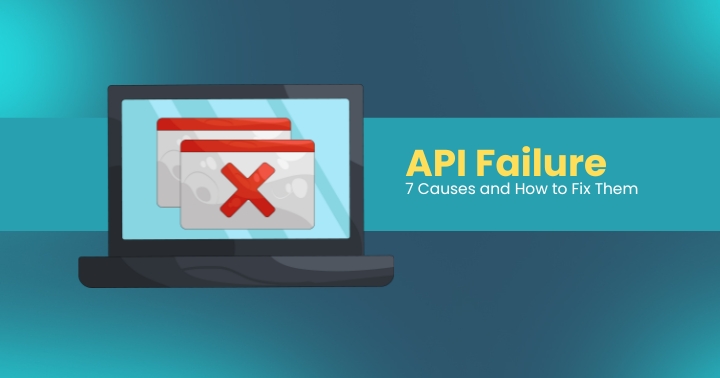APIs are the connective tissue of the internet. They move data between apps, enable integrations, and power everyday experiences from payment gateways to weather widgets. But when they stop working, everything built on top of them begins to fail.
An API failure can bring entire workflows to a halt. A single misconfigured endpoint might trigger a chain of “API request failed” messages, slow user logins, or block transactions mid-way. These aren’t just technical issues; they affect customer trust and business continuity.
The good news is that most API failures come from predictable and fixable causes. Once you know what to look for, you can prevent them long before they reach production.
What Is an API Failure
An API failure occurs when a client’s request doesn’t get a valid or expected response from the API server. Instead of the correct data, the server returns an empty payload, an error message, or nothing at all.
In plain terms, it means that the “conversation” between two systems has broken down. You might see errors like:
- “Error: server invite API down”
- “API error: fetch failed sending request”
- “An error occurred while contacting the API.”
Sometimes, the fault lies in authentication or token expiry; other times, it’s a coding error, bad URL, or version mismatch. A properly functioning API should return a 200-series HTTP status; anything in the 400 or 500 range indicates an error that needs attention.
For an in-depth understanding of how to diagnose these issues, visit Troubleshooting Guide for API Failure: Common Causes & Solutions.
Common API Error Codes and Their Meaning
To proactively test and reduce such issues, check out API Testing Automation and OWASP API Security Top 10.
7 Causes of Api Failure and How to Fix Them
1. Incorrect API Permissions
APIs rely on permissions to control who can access specific data. When access scopes or roles are configured incorrectly, users receive “API access denied” or “API call failed” messages even with valid credentials. This not only frustrates users but also breaks integrations dependent on certain permissions.
Fix:
Set up role-based access control (RBAC) and use least privilege principles so users only access what they need. Generate environment-specific keys and enforce granular scopes for different endpoints. Automated testing tools such as APIsec simulate real user permissions, ensuring endpoints behave correctly across different authorization levels.
2. Unsecured Endpoints and Weak Tokens
Unsecured endpoints are one of the biggest reasons behind both API failure and security breaches. When access tokens are exposed, expired, or transmitted without encryption, attackers can intercept data or disrupt service requests. Such vulnerabilities often manifest as “API error: fetch failed” or “API exception” during routine calls.
Fix:
Protect endpoints with HTTPS and use OAuth 2.0 or JWT-based authentication to secure token flows. Rotate access keys frequently and store them in encrypted vaults, never in source code. Our detailed post on Sensitive Data Exposure explains how token mismanagement leads to major breaches and downtime.
3. Invalid Session or Token Management
Invalid or expired sessions are a silent cause of recurring API errors. When session tokens time out or aren’t refreshed correctly, users experience inconsistent performance; one request succeeds while the next one fails with “failed to fetch from API for unknown reasons.” These issues often appear under load or after long inactivity.
Fix:
Implement short-lived tokens that automatically expire and refresh through secure flows. Track session validity across multiple devices, and make sure each new login invalidates previous sessions. Automated validation using APIsec’s platform ensures all session handling rules work properly across environments.
4. Expired or Deprecated APIs
APIs evolve, and when older versions are retired without proper version management, dependent apps start failing. Deprecated endpoints respond with 404 Not Found or 500 Internal Server Error, leaving developers guessing what changed.
Fix:
Maintain detailed API documentation and version logs. Use semantic versioning (v1, v2, etc.) and provide clear migration timelines for external consumers. Tools listed in Best API Documentation Tools simplify version control, helping teams update integrations smoothly before old endpoints are decommissioned.
5. Poorly Structured URLs
A malformed or inconsistent URL pattern confuses both developers and servers. Common symptoms include “Bad Request” or “API hit failed.” These often result from inconsistent naming conventions, missing path parameters, or unescaped special characters.
Fix:
Follow RESTful best practices, use nouns for resources, plural naming, and avoid symbols like < or ? in URLs. Document endpoints in OpenAPI format for consistency and clarity. The guide on Generating OpenAPI Specification (OAS) Documentation walks through building structured, scalable URL frameworks.
6. Overly Complex Endpoint Design
When a single API endpoint handles multiple unrelated functions, it becomes harder to debug and scale. Nested calls and chained logic increase latency, leading to “application failure” or “apierror” messages when one sub-request breaks. Complexity also confuses client developers trying to integrate the API.
Fix:
Break large endpoints into modular microservices and reduce dependencies between routes. Employ load balancers to distribute requests efficiently. APIsec helps identify overloaded or redundant endpoints by running automated discovery and stress testing across every API environment.
7. Exposed APIs on Public IPs
Publicly accessible APIs on open IPs are a common but dangerous oversight. Attackers can exploit these to perform brute-force attacks, causing system slowdowns or total outages marked as “An error occurred while contacting the API.”Without IP restrictions, even harmless bots can flood the network and degrade performance.
Fix:
Apply IP whitelisting, TLS encryption, and firewall rules to control access. Continuously monitor inbound traffic for anomalies. The post on Best API Security Practices outlines how endpoint discovery and runtime monitoring help identify exposure early.
How to Troubleshoot API Failures
When an API fails, time matters. Here’s a systematic process to diagnose problems before they affect users:
- Check Server Health: Ensure the backend service is operational and responding within normal latency.
- Inspect Network Requests: Use Postman, curl, or browser dev tools to inspect payloads and response headers.
- Review Logs: Identify any unhandled exceptions or configuration changes.
- Compare Environments: If it works in staging but fails in production, inspect environment variables and domain routing.
- Automate Re-Testing: Schedule continuous scans using APIsec Automated Testing to detect failures instantly.
For comprehensive troubleshooting, refer again to the Troubleshooting Guide for API Failure.
How to Prevent Future API Failures
Preventing API downtime is about catching problems before deployment. Consistent automation and good design habits go a long way:
- Automate Security Testing: Run continuous scans for logic flaws and configuration gaps using APIsec.
- Monitor in Real Time: Watch for latency spikes and sudden status code changes.
- Rotate Keys Frequently: Limit credential lifespan to reduce exposure.
- Integrate Testing into CI/CD: Validate every change automatically.
- Document and Version Properly: Keep endpoint details current and maintain backward compatibility.
- Simulate Traffic: Use stress testing to prepare APIs for peak load.
- Adopt Zero Trust: Never assume internal endpoints are safe by default.
Conclusion
API failures can start small an expired token, a misnamed route, or an outdated version, but their effects can spread fast. Each failure not only disrupts functionality but can also create security risks if left unchecked.
With APIsec, teams move from reaction to prevention. The platform automates API testing, simulates real-world traffic, validates permissions, and ensures endpoints behave exactly as expected. No more guesswork, no more hidden downtime.
Start your free APIsec signup today and experience continuous, automated API reliability and security for every environment.
Key Takeaways
- API failures usually stem from weak authentication, bad URLs, or outdated endpoints.
- Error codes help narrow down issues quickly: 400-series for client problems, 500-series for server faults.
- Automation ensures continuous visibility across builds, reducing the cost of manual debugging.
- Securing endpoints and documenting versions prevents many common outages.
- APIsec delivers proactive testing and validation to catch API issues before they break production.
FAQs
What causes APIs to fail most often?
Incorrect permissions, expired tokens, and outdated endpoints are the leading causes. Network latency and unhandled exceptions also play a role.
What does “API request failed” mean?
It means the client sent a request, but the server couldn’t return the expected data often due to a configuration or authentication issue.
How can I fix API exceptions quickly?
Check your authentication headers, verify endpoint URLs, and inspect logs for errors. Automated scans in APIsec can pinpoint exact failures instantly.
Can API errors be completely prevented?
Not entirely, but automated testing and strong version control drastically reduce their frequency and impact.
What’s the difference between 400 and 500 errors?
400-series codes are client-side issues (bad requests), while 500-series codes indicate server-side failures like logic bugs or crashes.
How does APIsec help avoid API downtime?
APIsec continuously tests, validates, and monitors your APIs, identifying permission errors, logic flaws, and misconfigurations before they cause downtime.
.webp)

.webp)

